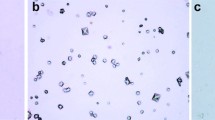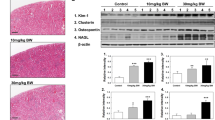Abstract
The occurrence of renal papillary necrosis (RPN), seen only in dogs after repeated oral administration of nefiracetam, a neurotransmission enhancer, at a relatively high dose, is because of inhibition of renal prostaglandin synthesis by the nefiracetam metabolite M-18. In this study, analyses of urinary proteins and renal mRNA expression were performed to investigate the possible existence of a specific protein expressing the characteristics of RPN evoked by nefiracetam. In the sodium dodecyl sulfate polyacrylamide gel electrophoresis (SDS–PAGE) of urinary proteins from male dogs given nefiracetam at 300 mg kg−1 day−1 over weeks 5–11, a protein of approximately 40 kDa, which was not seen in control urine, and protein of approximately 30 kDa emerged as distinct bands. Subsequently, clusterin precursor was identified in the former band and tissue kallikrein precursor in the latter by LC–electrospray ionization tandem mass spectrometry (LC–ESI-MS–MS). By quantitative real-time RT-PCR analysis with renal morphological aspects, individual findings showed that renal clusterin mRNA was increased in dogs with severe renal injury, and renal tissue kallikrein also increased, presumably related to hemodynamics. These results demonstrate that changes in renal clusterin mRNA may reflect the progression or severity of RPN, whereas upregulation of tissue kallikrein mRNA may subsequently play a compensating role in the prevention of RPN.


Similar content being viewed by others
References
Alden CL, Frith CH (1991) Urinary system. In: Haschek WM, Rousseaux CG (eds) Handbook of toxicologic pathology. Academic Press, New York, pp 347–348
Aulitzky WK, Schlegel PN, Wu D, Cheng CY, Chen CLC, Li PS, Goldstein M, Reidenberg M, Bardin CW (1992) Measurement of urinary clusterin as an index of nephrotoxicity. Proc Soc Exp Biol Med 199:93–96
Bach PH, Thanh NTK (1998) Renal papillary necrosis—40 years on. Toxicol Pathol 26:73–91
Bach PH, Scholey DJ, Delacruz L, Moret M, Nichol S (1991) Renal and urinary lipid changes associated with an acutely induced renal papillary necrosis in rats. Food Chem Toxicol 29:211–219
Bailey RW, Aronow B, Harmony JAK, Griswold MD (2002) Heat shock-initiated apoptosis is accelerated and removal of damaged cells is delayed in the testis of clusterin/ApoJ knock-out mice. Biol Reprod 66:1042–1053
Bailie MD (1992) Development of the endocrine function of the kidney. Clin Perinatol 19:59–68
Bennett WM, Henrich WL, Stoff JS (1996) The renal effects of nonsteroidal anti-inflammatory drugs: summary and recommendations. Am J Kidney Dis 28:S56–S62
Carretero OA, Scicli AG (1976) Renal kallikrein: its localization and possible role in renal function. Federation Proc 35:194–198
Chapdelaine P, Gauthier E, Ho-Kim MA, Bissonnette L, Tremblay RR, Dubé JY (1991) Characterization and expression of the prostatic arginine esterase gene, a canine glandular kallikrein. DNA Cell Biol 10:49–59
Clemo FAS (1998) Urinary enzyme evaluation of nephrotoxicity in the dog. Toxicol Pathol 26:29–32
Conner J, Buttyan R, Olsson CA, D‘Agati V, O’Toole K, Sawczuk IS (1991) SGP-2 expression as a genetic marker of progressive cellular pathology in experimental hedronephrosis. Kidney Int 39:1098–1103
DeFord SM, Wilson MS, Gibson CJ, Baranova A, Hamm RJ (2001) Nefiracetam improves Morris water maze performance following traumatic brain injury in rats. Pharmacol Biochem Behav 69:611–616
Hartmann K, Rauch J, Urban J, Parczyk K, Diel P, Pilarsky C, Appel D, Haase W, Mann K, Weller A, Koch-Brandt C (1991) Molecular cloning of gp 80, a glycoprotein complex secreted by kidney cells in vitro and in vivo. J Biol Chem 266:9924–9931
Hidaka S, Kränzlin B, Gretz N, Witzgall R (2002) Urinary clusterin levels in the rat correlate with the severity of tubular damage and may help to differentiate between glomerular and tubular injuries. Cell Tissue Res 310:289–296
Hildebrand M, Rinke G, Schlüter G, Bomhard E, Falkenberg FW (1999) Urinary antigens as markers of papillary toxicity II: application of monoclonal antibodies for the determination of papillary antigens in rat urine. Arch Toxicol 73:233–245
Hooks WN, Burford P, Begg S, Gopinath C, Inage F, Kato M, Takayama S (1994) Fifty-two-week oral toxicity study of the new cognition-enhancing agent nefiracetam in dogs. Arzneimittelforschung 44:228–238
Kashida Y, Yoshida M, Ishii Y, Nomura M, Kato M (1996) Examination of lesions in the urinary bladder and kidney of dogs induced by nefiracetam, a new nootropic agent. Toxicol Pathol 24:549–557
Kolaja GJ, Packwood WH, Bell RR, Ratke CC, Stout CL (1994) Renal papillary necrosis and urinary protein alterations induced in Fischer-344 rats by D-ormaplatin. Toxicol Pathol 22:29–38
Murthy K, Carretero OA, Scicli AG (1986) Purification and characterization of canine urinary kallikrein. Arch Biochem Biophys 244:563–571
Nabeshima T, Tohyama K, Murase K, Ishihara S, Kameyama T, Yamasaki T, Hatanaka S, Kojima H, Sakurai T, Takasu Y, Shiotani T (1991) Effects of DM-9384, a cyclilc derivative of GABA, on amnesia and decreases in GABAA and muscarinic receptors induced by cycloheximide. J Pharmacol Exp Ther 257:271–275
Ohnishi N, Ikekita M, Atomi Y, Kizuki K, Moriya H, Kondo K, Yamada H, Tsugita A (1992) Canine pancreatic kallikrein: enzyme isolation and characterization. Protein Seq Data Anal 5:1–5
Perkins DN, Pappin DJ, Creasy DM, Cottrell JS (1999) Probability-based protein identification by searching sequence database using mass spectrometry data. Electrophoresis 20:3551–3567
Sabatini S (1984) The pathophysiology of experimentally induced renal papillary necrosis. Semin Nephrol 4:27–39
Sakurai T, Ojima H, Yamasaki T, Kojima H, Akashi A (1989) Effects of N-(2,6-dimethylphenyl)-2-(2-oxo-1-pyrrolidinyl) acetamide (DM-9384) on learning and memory in rats. Jpn J Pharmacol 50:47–53
Sensiber JA, Griswold MD, Sylvester SR, Buttyan R, Bardin CW, Cheng CY, Dudek S, Lee C (1991) Prostatic ductal system in rats: regional variation in localization of an androgen-repressed gene product, sulfated glycoprotein-2. Endocrinology 128:2091–2102
Siragy HM, Jaffa AA, Margolius HS, Carey RM (1996) Renin-angiotensin system modulates renal bradykinin production. Am J Physiol 271:R1090–R1095
Sudo K, Hashimoto K, Fujimaki Y, Tachizawa H (1994) Disposition and metabolism of nefiracetam, a new nootropic agent, in the rat, dog and monkeys. Jpn Pharmacol Ther 22:81–92
Sugawara T, Kato M, Furuhama K, Inage F, Suzuki N, Akahane K, Takayama S (1994) Thirteen-week oral toxicity study of the new cognition-enhancing agent nefiracetam in dogs. Arzneimittelforschung 44:217–219
Thanh NTK, Obatomi DK, Bach PH (2001) Increased urinary uronic acid excretion in experimentally-induced renal papillary necrosis in rats. Renal Fail 23:31–42
Tsuchiya Y, Takahashi Y, Jindo T, Furuhama K, Suzuki KT (2003) Comprehensive evaluation of canine renal papillary necrosis induced by nefiracetam, a neurotransmission enhancer. Eur J Pharmacol 475:119–128
Yoshii M, Watabe S (1994) Enhancement of neuronal calcium channel currents by the nootropic agent, nefiracetam (DM-9384), in NG108-15 cells. Brain Res 642:123–131
Author information
Authors and Affiliations
Corresponding author
Rights and permissions
About this article
Cite this article
Tsuchiya, Y., Tominaga, Y., Matsubayashi, K. et al. Investigation on urinary proteins and renal mRNA expression in canine renal papillary necrosis induced by nefiracetam. Arch Toxicol 79, 500–507 (2005). https://doi.org/10.1007/s00204-005-0666-4
Received:
Accepted:
Published:
Issue Date:
DOI: https://doi.org/10.1007/s00204-005-0666-4




